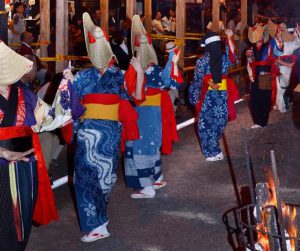JPA has launched a new project to present Bon Odori in New York City!
Do you know what Obon is? Obon is one of the Buddhist rituals during August 13-
Bon Odori can be divided into two categories. One of the categories is the standards that are known virtually anywhere in Japan. These music and dances are introduced by the National Bon Odori Preservation Association in Japan and anyone can use them to dance. The other category is regional specific music and dances. Usually these regional specific Bon Odori dances have hundreds of years of history, so only the locals can participate in the dance circle and tourists can watch them perform. Some of them are recognized as Japan’s national or regional intangible heritages.
Among the hundreds of these regional specific Bon Odori dances, there are those called “The Big Three Bon Odori.” They are: Nishimonai Bon Odori (Akita prefecture), Gujo Odori (Gifu prefecture) and Awa Odori (Tokushima prefecture). These dances are considered as special regional Bon Odori and two of them are only performed by the trained locals. However, JPA obtained a special permission to teach these dances from each of the regional preservation associations and we will have practice sessions various Bon Odori events!
 The Nishimonai Bon Odori (
The Nishimonai Bon Odori ( Gujō Odori (郡上おどり) is a Bon Festival held every summer in Gujō, Gifu, Japan. The dance festival’s origins have been traced back to the Kan’ei era (1624–44), when it is believed to have originated as an exercise in social cohesion; it has been designated an Important Intangible Folk Cultural Property.
Gujō Odori (郡上おどり) is a Bon Festival held every summer in Gujō, Gifu, Japan. The dance festival’s origins have been traced back to the Kan’ei era (1624–44), when it is believed to have originated as an exercise in social cohesion; it has been designated an Important Intangible Folk Cultural Property. The Awa Dance Festival (
The Awa Dance Festival (